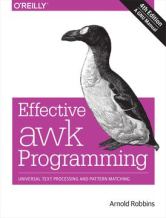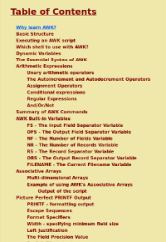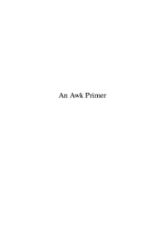Last Updated on May 22, 2022
Awk is a versatile programming language designed for pattern scanning and processing language and often used as a data extraction and reporting tool. It’s an excellent filter and report writer. It’s a standard feature of most Unix-like operating systems.
Awk is small, fast, simple, and has a clean comprehensible C-like input language. It has robust programming constructs including if/else, while, do/while and for C-style and array iteration.
The name awk comes from the initials of its designers: Alfred V. Aho, Peter J. Weinberger, and Brian W. Kernighan. The original version of awk was written in 1977 at AT&T Bell Laboratories.
The language is suited for:
- Tallying information from text files and creating reports from the results.
- Adding additional functions to text editors like “vi”.
- Translating files from one format to another.
- Creating small databases.
- Performing mathematical operations on files of numeric data.
There’s a limited range of good free books to learn about programming in Awk. Here’s my recommended texts.
1. GAWK: Effective AWK Programming Edition 5.0 by Arnold D. Robbins
 This practical guide serves as both a reference and tutorial for POSIX-standard awk and for the GNU implementation, called gawk. This book is useful for novices and awk experts alike.
This practical guide serves as both a reference and tutorial for POSIX-standard awk and for the GNU implementation, called gawk. This book is useful for novices and awk experts alike.
GAWK: Effective AWK Programming explains both how to write programs in the awk language and how to run the awk utility. The term “awk program” refers to software written in the awk programming language.
The book serves as both a tutorial and reference guide. The first part of the book describes the awk language and the gawk program in detail. The second part of the book shows you how to use awk and gawk to solve problems. The third part concentrates on features specific to gawk. The final part of the book provides appendices, and a useful Glossary. There’s a wealth of information in the book.
Read the 5th edition in PDF format at https://www.gnu.org/software/gawk/manual/gawk.pdf.
Permission is granted to copy, distribute and/or modify GAWK: Effective AWK Programming Edition under the terms of the GNU Free Documentation License, Version 1.3.
The book’s cover relates to the 4th edition published by O’Reilly.
2. Awk Tutorial by Bruce Barnett
 Awk Tutorial discusses Awk, a cornerstone of UNIX shell programming.
Awk Tutorial discusses Awk, a cornerstone of UNIX shell programming.
Chapters cover:
- Executing an Awk script.
- Which shell to use with Awk?
- Dynamic Variables.
- Arithmetic Expressions.
- Summary of Awk Commands.
- Awk Built-in Variables: FS, OFS, NF, NR, RS, ORS, and FILENAME.
- Associative Arrays.
- Picture Perfect PRINTF Output.
- Flow Control with next and exit.
- Awk Numerical Functions.
- String Functions.
- User Defined Functions.
- Awk patterns.
- Formatting Awk programs.
Read the tutorial at https://www.grymoire.com/Unix/Awk.html.
3. An Awk Primer by Wikibooks
 An Awk Primer is a useful guide which explains Awk’s syntax in some depth covering search patterns, numbers and strings, variables, arrays, operations, standard functions, user-defined functions, control structures, and more.
An Awk Primer is a useful guide which explains Awk’s syntax in some depth covering search patterns, numbers and strings, variables, arrays, operations, standard functions, user-defined functions, control structures, and more.
There’s also some example Awk program files, and a quick reference guide.
Read the book online at https://en.wikibooks.org/wiki/An_Awk_Primer. There’s a printable version available here.
Permission is granted to copy, distribute, and/or modify An Awk Primer under the terms of the Creative Commons Attribution-ShareAlike 3.0 License.
All books in this series:
| Free Programming Books | |
|---|---|
| Ada | ALGOL-like programming language, extended from Pascal and other languages |
| Agda | Dependently typed functional language based on intuitionistic Type Theory |
| Arduino | Inexpensive, flexible, open source microcontroller platform |
| Assembly | As close to writing machine code without writing in pure hexadecimal |
| Awk | Versatile language designed for pattern scanning and processing language |
| Bash | Shell and command language; popular both as a shell and a scripting language |
| BASIC | Beginner’s All-purpose Symbolic Instruction Code |
| C | General-purpose, procedural, portable, high-level language |
| C++ | General-purpose, portable, free-form, multi-paradigm language |
| C# | Combines the power and flexibility of C++ with the simplicity of Visual Basic |
| Clojure | Dialect of the Lisp programming language |
| ClojureScript | Compiler for Clojure that targets JavaScript |
| COBOL | Common Business-Oriented Language |
| CoffeeScript | Transcompiles into JavaScript inspired by Ruby, Python and Haskell |
| Coq | Dependently typed language similar to Agda, Idris, F* and others |
| Crystal | General-purpose, concurrent, multi-paradigm, object-oriented language |
| CSS | CSS (Cascading Style Sheets) specifies a web page’s appearance |
| D | General-purpose systems programming language with a C-like syntax |
| Dart | Client-optimized language for fast apps on multiple platforms |
| Dylan | Multi-paradigm language supporting functional and object-oriented coding |
| ECMAScript | Best known as the language embedded in web browsers |
| Eiffel | Object-oriented language designed by Bertrand Meyer |
| Elixir | Relatively new functional language running on the Erlang virtual machine |
| Erlang | General-purpose, concurrent, declarative, functional language |
| F# | Uses functional, imperative, and object-oriented programming methods |
| Factor | Dynamic stack-based programming language |
| Forth | Imperative stack-based programming language |
| Fortran | The first high-level language, using the first compiler |
| Go | Compiled, statically typed programming language |
| Groovy | Powerful, optionally typed and dynamic language |
| Haskell | Standardized, general-purpose, polymorphically, statically typed language |
| HTML | HyperText Markup Language |
| Icon | Wide variety of features for processing and presenting symbolic data |
| J | Array programming language based primarily on APL |
| Java | General-purpose, concurrent, class-based, object-oriented, high-level language |
| JavaScript | Interpreted, prototype-based, scripting language |
| Julia | High-level, high-performance language for technical computing |
| Kotlin | More modern version of Java |
| LabVIEW | Designed to enable domain experts to build power systems quickly |
| LaTeX | Professional document preparation system and document markup language |
| Lisp | Unique features - excellent to study programming constructs |
| Logo | Dialect of Lisp that features interactivity, modularity, extensibility |
| Lua | Designed as an embeddable scripting language |
| Markdown | Plain text formatting syntax designed to be easy-to-read and easy-to-write |
| Objective-C | Object-oriented language that adds Smalltalk-style messaging to C |
| OCaml | The main implementation of the Caml language |
| Pascal | Imperative and procedural language designed in the late 1960s |
| Perl | High-level, general-purpose, interpreted, scripting, dynamic language |
| PHP | PHP has been at the helm of the web for many years |
| PostScript | Interpreted, stack-based and Turing complete language |
| Prolog | A general purpose, declarative, logic programming language |
| PureScript | Small strongly, statically typed language compiling to JavaScript |
| Python | General-purpose, structured, powerful language |
| QML | Hierarchical declarative language for user interface layout - JSON-like syntax |
| R | De facto standard among statisticians and data analysts |
| Racket | General-purpose, object-oriented, multi-paradigm, functional language |
| Raku | Member of the Perl family of programming languages |
| Ruby | General purpose, scripting, structured, flexible, fully object-oriented language |
| Rust | Ideal for systems, embedded, and other performance critical code |
| Scala | Modern, object-functional, multi-paradigm, Java-based language |
| Scheme | A general-purpose, functional language descended from Lisp and Algol |
| Scratch | Visual programming language designed for 8-16 year-old children |
| SQL | Access and manipulate data held in a relational database management system |
| Standard ML | General-purpose functional language characterized as "Lisp with types" |
| Swift | Powerful and intuitive general-purpose programming language |
| Tcl | Dynamic language based on concepts of Lisp, C, and Unix shells |
| TeX | Markup and programming language - create professional quality typeset text |
| TypeScript | Strict syntactical superset of JavaScript adding optional static typing |
| Vala | Object-oriented language, syntactically similar to C# |
| VHDL | Hardware description language used in electronic design automation |
| VimL | Powerful scripting language of the Vim editor |
| XML | Rules for defining semantic tags describing structure ad meaning |
